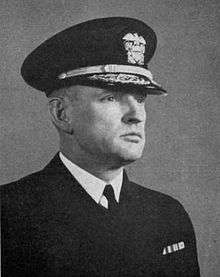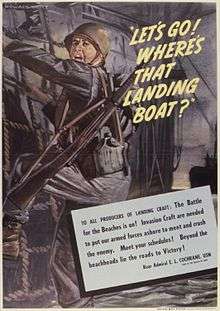Edward L. Cochrane
Vice Admiral Edward Lull "Ned" Cochrane (March 18, 1892 – November 14, 1959) was a United States Navy officer and naval architect who served as Chief of the Bureau of Ships during World War II. In this capacity, he was directly responsible for the Navy's massive shipbuilding and maintenance program from November 1942 until November 1946.
Edward Lull Cochrane | |
|---|---|
 | |
| Born | March 18, 1892 Mare Island, California |
| Died | November 14, 1959 (aged 67) New Haven, Connecticut |
| Allegiance | |
| Service/ | |
| Years of service | 1910–1947 |
| Rank | |
| Commands held | Chief of the Bureau of Ships |
| Battles/wars | World War I World War II |
| Awards | Distinguished Service Medal Knight Commander of the Order of the British Empire (honorary) |
| Relations | Henry Clay Cochrane (father) |
| Other work | Dean of MIT School of Engineering |
Naval career

The son of retired Marine Brigadier General Henry Clay Cochrane (1842–1913), Edward Lull Cochrane was born at Mare Island, California in 1892.[1] He entered the United States Naval Academy in 1910 and was commissioned as a Navy ensign upon graduation in 1914. During World War I, he served at Philadelphia Naval Shipyard and transferred to the Navy's Construction Corps. He graduated in 1920 from the Massachusetts Institute of Technology (MIT), with a Master of Science degree in Naval Architecture.[2]
Between the World Wars, Cochrane served in various positions related to shipbuilding, including in the Navy's Bureau of Construction and Repair, predecessor to the Bureau of Ships.
He assumed the post of Chief, BuShips in November 1942, succeeding Rear Admiral Alexander H. Van Keuren.[3][4] From January 1941 until assuming command of the bureau, Cochrane served as the Assistant Head of the Design Division.[2]
Academic career
Cochrane retired from the navy in 1947, while serving as a member of the President's Advisory Committee on the Merchant Marine.[2] He then joined the faculty of MIT, serving from 1947 to 1950 as head of the Department of Ocean Engineering (originally known as the Department of Naval Architecture),[5] and from 1952 to 1954 as head of the School of Engineering.[6]
Last years and legacy
Vice Admiral Cochrane died in New Haven, Connecticut, on November 14, 1959, at the age of 67.[7]
Many of Vice Admiral Cochrane's papers are held at the Naval Historical Center at the Washington Navy Yard in Washington, D.C. The papers include documents pertaining to the reorganization of the Bureau of Ships during World War II as well as transcripts of official speeches given by Admiral Cochrane during his term as head of that Bureau. Additionally, there are many personal papers and photographs relating to the Admiral's close association with civilian Naval Architecture and engineering organizations.[8]
A small amount of related papers, focusing on his student years at MIT, are also available at the MIT Institute Archives and Special Collections.
Awards and honors
Cochrane received many awards and honors for his contributions to naval architecture, including the David W. Taylor Medal,[2] and more generally to the field of engineering. He was a member of the National Academy of Sciences,[9] and in 1953 received honorary membership in the American Society of Mechanical Engineers (ASME).[10]
Cochrane was also awarded the Distinguished Service Medal, and was an honorary Knight Commander of the Order of the British Empire.[2]
MIT's Admiral Edward L. Cochrane Award is presented each year to an outstanding student athlete. The award goes to a male senior for demonstrating humility, leadership and inspiration in intercollegiate sports.[11]
The USS Cochrane (DDG-21), a Charles F. Adams-class guided missile armed destroyer, was named in his honor.
Admiral Cochrane Drive in Annapolis was named in his honor.
References
| Wikimedia Commons has media related to Edward L. Cochrane. |
- "Edward Lull Cochrane". usscochrane.org. Retrieved 8 August 2010.
- "Admiral Cochrane Dies: Headed Industrial Liaison" (PDF). The Tech. Massachusetts Institute of Technology. November 20, 1959. Retrieved 8 August 2010.
- "The Official Chronology of the U.S. Navy in World War II : Principal Civilian Officials And Naval Officers In Command 7 December 1941 - 2 September 1945". ibiblio.org. Retrieved 8 August 2010.
- "Assignments To Duty". Time. 26 October 1942. Retrieved 8 August 2010.
- "History: Department of Ocean Engineering: Institute Archives & Special Collections: MIT". libraries.mit.edu. Retrieved 8 August 2010.
- "History: School of Engineering: Institute Archives & Special Collections: MIT". libraries.mit.edu. Retrieved 8 August 2010.
- "Milestones, Nov. 30, 1959". Time. 30 November 1959. Retrieved 8 August 2010.
- "Papers of Vice Admiral Edward L. Cochrane". history.navy.mil. Archived from the original on 6 December 2010. Retrieved 8 August 2010.
- "National Academy of Sciences: List of Biographical Memoirs". nasonline.org. Archived from the original on 29 June 2010. Retrieved 8 August 2010.
- "Honorary Member - Society Awards". asme.org. Retrieved 8 August 2010.
- "MIT News : Athletics confers sports awards". web.mit.edu. Retrieved 8 August 2010.
External links
- Spanish–American War Centennial Website : A Brief Biography of Major Henry Clay Cochrane, U.S.M.C., Assistant Executive Officer, First Marine Battalion.
- National Academy of Sciences : Biographical Memoir of Edward L. Cochrane
- National Academy of Sciences Biographical Memoir
- Papers of Edward L. Cochrane, Operational Archives Branch, Naval Historical Center, Washington, D.C.
![]()